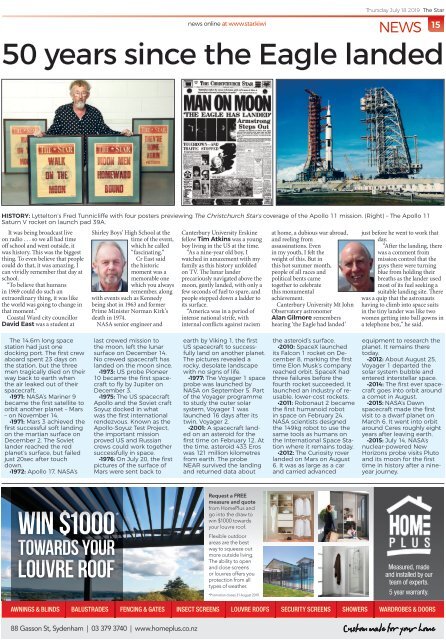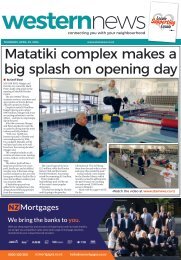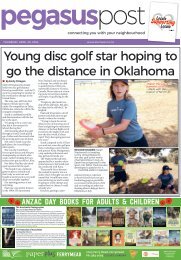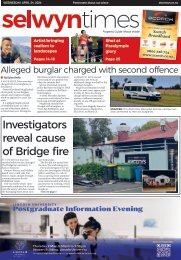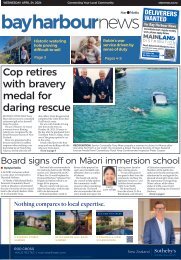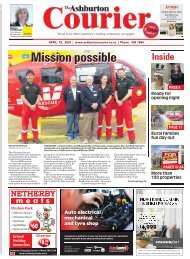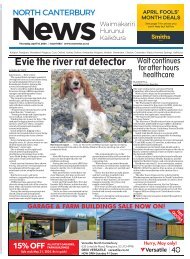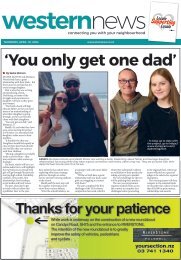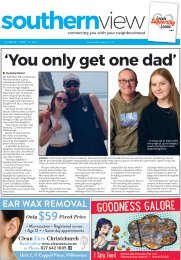The Star: July 18, 2019
You also want an ePaper? Increase the reach of your titles
YUMPU automatically turns print PDFs into web optimized ePapers that Google loves.
Thursday <strong>July</strong> <strong>18</strong> <strong>2019</strong> <strong>The</strong> <strong>Star</strong><br />
news online at www.star.kiwi<br />
NEWS 15<br />
50 years since the Eagle landed<br />
HISTORY: Lyttelton’s Fred Tunnicliffe with four posters previewing <strong>The</strong> Christchurch <strong>Star</strong>’s coverage of the Apollo 11 mission. (Right) – <strong>The</strong> Apollo 11<br />
Saturn V rocket on launch pad 39A.<br />
It was being broadcast live<br />
on radio . . . so we all had time<br />
off school and went outside, it<br />
was history. This was the biggest<br />
thing. To even believe that people<br />
could do that, it was amazing. I<br />
can vividly remember that day at<br />
school.<br />
“To believe that humans<br />
in 1969 could do such an<br />
extraordinary thing, it was like<br />
the world was going to change in<br />
that moment.”<br />
Coastal Ward city councillor<br />
David East was a student at<br />
Shirley Boys’ High School at the<br />
time of the event,<br />
which he called<br />
“fascinating.”<br />
Cr East said<br />
the historic<br />
moment was a<br />
memorable one<br />
which you always<br />
remember, along<br />
with events such as Kennedy<br />
being shot in 1963 and former<br />
Prime Minister Norman Kirk’s<br />
death in 1974.<br />
NASA senior engineer and<br />
Canterbury University Erskine<br />
fellow Tim Atkins was a young<br />
boy living in the US at the time.<br />
“As a nine-year old boy, I<br />
watched in amazement with my<br />
family as this history unfolded<br />
on TV. <strong>The</strong> lunar lander<br />
precariously navigated above the<br />
moon, gently landed, with only a<br />
few seconds of fuel to spare, and<br />
people stepped down a ladder to<br />
its surface.<br />
“America was in a period of<br />
intense national strife, with<br />
internal conflicts against racism<br />
at home, a dubious war abroad,<br />
and reeling from<br />
assassinations. Even<br />
in my youth, I felt the<br />
weight of this. But in<br />
this hot summer month,<br />
people of all races and<br />
political bents came<br />
together to celebrate<br />
this monumental<br />
achievement.<br />
Canterbury University Mt John<br />
Observatory astronomer<br />
Alan Gilmore remembers<br />
hearing ‘the Eagle had landed’<br />
just before he went to work that<br />
day.<br />
“After the landing, there<br />
was a comment from<br />
mission control that the<br />
guys there were turning<br />
blue from holding their<br />
breaths as the lander used<br />
most of its fuel seeking a<br />
suitable landing site. <strong>The</strong>re<br />
was a quip that the astronauts<br />
having to climb into space suits<br />
in the tiny lander was like two<br />
women getting into ball gowns in<br />
a telephone box,” he said.<br />
<strong>The</strong> 14.6m long space<br />
station had just one<br />
docking port. <strong>The</strong> first crew<br />
aboard spent 23 days on<br />
the station, but the three<br />
men tragically died on their<br />
way back to earth when<br />
the air leaked out of their<br />
spacecraft.<br />
•1971: NASA’s Mariner 9<br />
became the first satellite to<br />
orbit another planet – Mars<br />
– on November 14.<br />
•1971: Mars 3 achieved the<br />
first successful soft landing<br />
on the martian surface on<br />
December 2. <strong>The</strong> Soviet<br />
lander reached the red<br />
planet’s surface, but failed<br />
just 20sec after touch<br />
down.<br />
•1972: Apollo 17, NASA’s<br />
last crewed mission to<br />
the moon, left the lunar<br />
surface on December 14.<br />
No crewed spacecraft has<br />
landed on the moon since.<br />
•1973: US probe Pioneer<br />
10 became the first spacecraft<br />
to fly by Jupiter on<br />
December 3.<br />
•1975: <strong>The</strong> US spacecraft<br />
Apollo and the Soviet craft<br />
Soyuz docked in what<br />
was the first international<br />
rendezvous. Known as the<br />
Apollo-Soyuz Test Project,<br />
the important mission<br />
proved US and Russian<br />
crews could work together<br />
successfully in space.<br />
•1976: On <strong>July</strong> 20, the first<br />
pictures of the surface of<br />
Mars were sent back to<br />
earth by Viking 1, the first<br />
US spacecraft to successfully<br />
land on another planet.<br />
<strong>The</strong> pictures revealed a<br />
rocky, desolate landscape<br />
with no signs of life.<br />
•1977: <strong>The</strong> Voyager 1 space<br />
probe was launched by<br />
NASA on September 5. Part<br />
of the Voyager programme<br />
to study the outer solar<br />
system, Voyager 1 was<br />
launched 16 days after its<br />
twin, Voyager 2.<br />
•2001: A spacecraft landed<br />
on an asteroid for the<br />
first time on February 12. At<br />
the time, asteroid 433 Eros<br />
was 121 million kilometres<br />
from earth. <strong>The</strong> probe<br />
NEAR survived the landing<br />
and returned data about<br />
the asteroid’s surface.<br />
•2010: SpaceX launched<br />
its Falcon 1 rocket on December<br />
8, marking the first<br />
time Elon Musk’s company<br />
reached orbit. SpaceX had<br />
three failures before the<br />
fourth rocket succeeded. It<br />
launched an industry of reusable,<br />
lower-cost rockets.<br />
•2011: Robonaut 2 became<br />
the first humanoid robot<br />
in space on February 24.<br />
NASA scientists designed<br />
the 149kg robot to use the<br />
same tools as humans on<br />
the International Space Station<br />
where it remains today.<br />
•2012: <strong>The</strong> Curiosity rover<br />
landed on Mars on August<br />
6. It was as large as a car<br />
and carried advanced<br />
equipment to research the<br />
planet. It remains there<br />
today.<br />
•2012: About August 25,<br />
Voyager 1 departed the<br />
solar system bubble and<br />
entered interstellar space.<br />
•2014: <strong>The</strong> first ever spacecraft<br />
goes into orbit around<br />
a comet in August.<br />
•2015: NASA’s Dawn<br />
spacecraft made the first<br />
visit to a dwarf planet on<br />
March 6. It went into orbit<br />
around Ceres roughly eight<br />
years after leaving earth.<br />
•2015: <strong>July</strong> 14, NASA’s<br />
nuclear-powered New<br />
Horizons probe visits Pluto<br />
and its moon for the first<br />
time in history after a nineyear<br />
journey.<br />
TOWARDS YOUR<br />
WIN $1000<br />
LOUVRE ROOF<br />
Request a FREE<br />
measure and quote<br />
from HomePlus and<br />
go into the draw to<br />
win $1000 towards<br />
your louvre roof.<br />
Flexible outdoor<br />
areas are the best<br />
way to squeeze out<br />
more outside living.<br />
<strong>The</strong> ability to open<br />
and close screens<br />
or louvres offers you<br />
protection from all<br />
types of weather.<br />
*Promotion closes 31 August <strong>2019</strong>.<br />
Measured, made<br />
and installed by our<br />
team of experts.<br />
5 year warranty.<br />
88 Gasson St, Sydenham | 03 379 3740 | www.homeplus.co.nz


